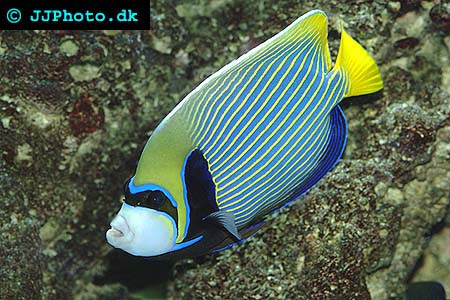Tag Archives: language
Beluga whale trained to link sounds to items
A 23-year old Beluga whale at the Kamogawa Sea World aquarium in Japan has been trained to emit different noises for different items. As of now, the whale – whose name is Nack – emits a short, high-pitched sound to identify diving fins, a long and even more high-pitched sound for diving goggles, and a short, lower sound for bucket. When the sounds are recorded and played back to Nack, he is able to identify the corresponding object.
Takashi Murayama, a professor at Tokai University, has been training Nack for the last five years. He is now trying to teach Nack to emit different noises for different people, and he also wishes Nack to be able to express opinions, e.g. use sounds to tell his trainer about his likes and dislikes, or if something is boring or painful.
Fish are not only beautiful to please aquarists, Professor Bellwood reveals
Imperator angelfish – Copyright www.jjphoto.dk
Colour in fish is probably an advanced for of communication, according to Professor David Bellwood of the ARC Centre of Excellence for Coral Reef Studies and James Cook University, Queensland. In an article in Telegraph.co.uk, Professor Bellwood shares his knowledge about fossil specimens of reef fish from Monte Bolca, Italy. By studying these prehistoric fishes, Professor Bellwood was able to determine that spotted and striped fishes have been swimming in our oceans for at least 50 million years. According to Professor Bellwood, it is probable that they also were very colourful.
So, why would a fish devote so much energy to the development of vivid colours and attractive patterns? According to Professor Bellwood, the look of a fish might be a way for fishes to communicate with each other. It can for instance be used to broadcast status in a pecking order or find a suitable mate. Colours and patterns can also be used to send out disinformation, e.g. in order to confuse predators. A dark spot near the end of the tail can for instance cause a predator to attack the tail instead of going for the real head of the fish. This type of fake eye is not a new thing in the kingdom of fishes; it appears on million year old fish fossils.
“Bright colouring is clearly a highly successful trait. The odd thing is that mammals, including humans, appear to have lost it.” says Professor Bellwood.
You can learn more about the secret language of fish here: http://www.telegraph.co.uk/earth/main.jhtml?xml=/earth/2008/02/20/scifish120.xml

